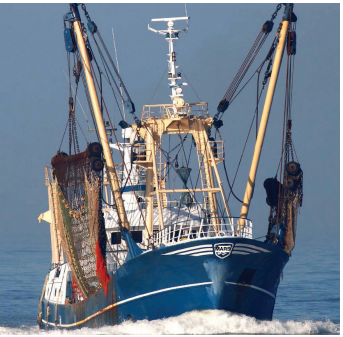202414 : Poor situational awareness leads to collision
A general cargo vessel was proceeding in a Traffic Separation Scheme (TSS) at reduced power due to engine problems, making 4.5 knots at dead slow ahead. It was dark, but visibility was good.
As edited from the Dutch Safety Board report, published August 2023 http://tinyurl.com/MARS202414
On the bridge the OOW was accompanied by a lookout. The Closest Point of Approach (CPA) alarm was triggered on the ECDIS, and the OOW observed that a vessel was approaching them from astern, with a CPA of 0.2nm.
After acquiring the vessel on the ECDIS, the OOW recognised the target was a fishing vessel. The CPA was now 0.1nm and the vessel was doing about 9 knots. The fishing vessel was in sight from the wheelhouse and the OOW estimated that it would overtake them on their port side.
Concerned about the small CPA, the OOW called the fishing boat on the VHF Channel 16 but received no reply. He observed that the fishing vessel had appeared to execute a minor course change, and he noticed a slightly increased CPA. Satisfied that his call had been received, the OOW then sat down at the desk in the wheelhouse to carry out some administrative tasks. From that position, he had no direct view of the radar screen. The lookout, now focused on the situation ahead, did not look astern again. Some minutes later, the fishing vessel hit the stern of the cargo vessel. The lone watchkeeper on the fishing vessel felt a bump and looked forward, but he did not see the cargo vessel. A second and third bump followed. The Master of the fishing vessel arrived in the wheelhouse. As the fishing vessel altered course, they saw the lights of the cargo vessel and realised they had bumped into its stern.
The cargo vessel suffered a hole in its stern in way of the steering gear compartment. Taking on water, the vessel had to make a deviation to a port of refuge. Among other things, the investigation found that the cargo vessel’s small size and low freeboard made it difficult to see the white stern light, which was positioned just above the waterline. Additionally, the fishing vessel was trimmed aft, and had masts that hindered the view of low objects forward (see image below), again making visual detection of the cargo vessel difficult. The report also found that the CPA alarm on board the fishing vessel was not activated prior to the collision.

Lessons learned
- Notwithstanding the low aspect presented by the cargo vessel and the poor visibility from the fishing vessel’s wheelhouse, there is no substitute for keeping a sharp lookout by all available means. There really is no excuse for bumping into another vessel ahead and not even knowing what happened.
- Never assume a situation is clear until it is truly clear. In this case the OOW of the cargo vessel attended to other duties after assuming the fishing vessel was taking the appropriate action to avoid his vessel.
- CPA alarms are a welcome tool – keep them active
